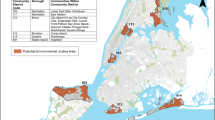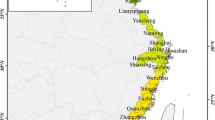Abstract
Climate change may affect the frequency, intensity, and geographic distribution of severe coastal storms. Concurrent sea-level rise would raise the baseline of flooding during such events. Meanwhile, social vulnerability factors such as poverty and disability hinder the ability to cope with storms and storm damage. While physical changes are likely to remain scientifically uncertain into the foreseeable future, the ability to mitigate potential impacts from coastal flooding may be fostered by better understanding the interplay of social and physical factors that produce human vulnerability. This study does so by integrating the classic causal model of hazards with social, environmental, and spatial dynamics that lead to the differential ability of people to cope with hazards. It uses Census data, factor analysis, data envelopment analysis, and floodplain maps to understand the compound social and physical vulnerability of coastal residents in the city of Revere, MA, USA.
Similar content being viewed by others
References
Bijlsma, L. et al.: 1996, Coastal zones and small islands. In: Watson, Robert T. et al. (eds.), Climate Change 1995: Impacts, Adaptations and Mitigation of Climate Change: Scientific-Technical Analyses. Contribution of Working Group II to the Second Assessment Report of the Intergovernmental Panel on Climate Change, 299-324. Cambridge, UK: Cambridge University Press.
Blaikie, P.: 1985, The Political Economy of Soil Erosion in Developing Countries. Harlow, England: Longman.
Blaikie, P. M., Cannon, T., Davis, I. and Wisner, B.: 1994, At Risk: Natural Hazards, People's Vulnerability, and Disasters. London: Routledge.
Bohle, H. G., Downing, T. E. and Watts, M. J.: 1994, Climate change and social vulnerability: towards a sociology and geography of food insecurity. Global Environmental Change 4: 37-48.
Bolin, R.: 1982, Long-Term Family Recovery from Disaster. Monograph # 36. Boulder, CO.: Institute of Behavioral Science, University of Colorado.
Bolin, R. and Bolton, P.: 1986, Race, Religion, and Ethnicity in Disaster Recovery. Program on Environment and Behavior Monograph # 42. Boulder, CO.: Institute of Behavioral Science, University of Colorado.
Bolin, R. and Klenow, D.: 1983, Response of the elderly to disaster: an age-stratified analysis. International Journal of Aging and Human Development 16: 283-296.
Bolin, R. and Stanford, L.: 1991, Shelter, housing, and recovery: A comparison of U.S. disasters. Disasters 15: 24-34.
Bruce, J. P., Lee, H. and Haites, E. F., (eds.): 1996, Climate Change 1995: Economic and Social Dimensions of Climate Change. Contributions of Working Group III to the Second Assessment Report of the Intergovernmental Panel on Climate Change. New York, NY: Cambridge University Press.
Cash, D.: 1997, Local response to global change: Creating effective bridges between science, policy and action. Paper prepared for the workshop on Regional Climate Change Impacts on Great Plains Ecosystems, May 27-29, 1997, Fort Collins, CO.
Charnes, A., Cooper, W. W. and Rhodes, E.: 1979, Measuring the efficiency for decisionmaking units. European Journal of Operational Research 2.
Chen, R. S.: 1994, The human dimensions of vulnerability. In R. H. Socolow, C. Andrews, F. Berkhout, and V. Thomas (eds.), Industrial Ecology and Global Change. Cambridge: Cambridge University Press, 85-105.
Clark, W. C., Jager, J. and van Eijndhoven, J. (eds.): Forthcoming. Learning to Manage Global Environmental Risks: A Comparative History of Social Responses to Climate Change, Ozone Depletion, and Acid Rain. Cambridge,MA: MIT Press.
Corps of Engineers: 1979, A Report on the Assessment of Flood Damages Resulting from the Storm of 6-7 February 1978 along the Coastline from Orleans, Massachusetts to New Castle, New Hampshire. February. Waltham, MA.: U. S. Army Corps of Engineers, New England Division.
Cutter, S. L.: 1996, Vulnerability to environmental hazards. Progress in Human Geography 20: 529-539.
Dow, K.: 1992, Exploring differences in our common future(s): The meaning of vulnerability to global environmental change. Geoforum 23: 417-436.
Dow, K.: 1993, Unpublished literature review on the 'concept of vulnerability' and the 'factors contributing to vulnerability'. Worcester: George Perkins Marsh Institute, Clark University.
Dow, K. and Downing, T. E.: 1995, Vulnerability research: where things stand. Human Dimensions Quarterly 1: 3-5.
Drabek, T. E., and Key, W. H.: 1984, Conquering Disaster: Family Recovery and Long-Term Consequences. New York: Irvington.
Global Environmental Assessment Project: 1997, A Critical Evaluation of Global Environmental Assessments: the Climate Experience. Calverton, MD: CARE.
Godschalk, D. R., Brower, D. J. and Beatley, T.: 1989, Catastrophic Coastal Storms. Durham, NC.: Duke University Press.
Haas, J. E., Kates, R. W. and Bowden, M. J.: 1977, Reconstruction Following Disaster. Cambridge, MA.: MIT Press.
Haynes, K., Ratick, S., Bowen, W. and Cummings-Saxton, J.: 1993, Environmental decision models: U.S. experiences and new approaches to pollution management. Environment International 19: 200-220.
Hewitt, K., (ed.): 1983, Interpretations of Calamity. Boston: Allen & Unwin, Inc.
Hewitt, K.: 1997, Regions of Risk: A Geographical Introduction to Disasters. London: Longman.
Hewitt, K., and Burton, I.: 1971, The Hazardousness of a Place: A Regional Ecology of Damaging Events.Department of Geography Research Publications. Toronto: University of Toronto Press.
Hohenemser, C., Kasperson, R. E. and Kates, R. W.: 1985, Causal structure. In R. W. Kates, C. Hohenemser, and J. X. Kasperson (ed.), Perilous Progress: Managing the Hazards of Technology, 43-66. Boulder, CO.: Westview Press.
Hunt, R.: 1990, Saugus River and Tributaries Flood Damage Reduction Study, Lynn, Malden, Revere, and Saugus, Massachusetts. April. Waltham, MA.: U. S. Army Corps of Engineers, New England Division.
Kotlyakov, V. M. et al.: 1988, Global change: Geographical approaches (a review). Proceedings of the National Academy of Sciences USA, 85 (August): 5986-5991.
Liverman, D. M.: 1990, Vulnerability to global environmental change. In R. E. Kasperson, K. Dow, D. Golding, and J. X. Kasperson (eds.), Understanding Global Environmental Change: The Contributions of Risk Analysis and Management. Worcester, MA.: Earth Transformed Program, Clark University.
Mitchell, J. K.: 1984, Hazard perception studies: Convergent concerns and divergent approaches during the past decade. In T. F. Saarinen, D. Seamon, and J. L. Sell, eds., Environmental Perception and Behavior: An Inventory and Prospect, 33-59. Research Paper No. 209. Chicago: Department of Geography, University of Chicago.
Moser, S. C.: 1997, Mapping the Territory of Uncertainty and Ignorance: Broadening Current Assessment and Policy Approaches to Sea-Level Rise. Dissertation. Worcester, MA: Clark University.
Mitchell, J. K.: 1984, Hazard perception studies: Convergent concerns and divergent approaches during the past decade. In T. F. Saarinen, D. Seamon, and J. L. Sell (ed.), Environmental Perception and Behavior: An Inventory and Prospect, 33-59. Research Paper No. 209. Chicago: Department of Geography, University of Chicago.
Nealon, P. and Brelis, B.: 1996, The eastcoaster of' 96: N. E. digs out; forecasters say to dig in for more. The Boston Globe(January 9):1,21.
NRC (National Research Council): 1984, Hurricane Diana, North Carolina, September 10-14, 1984. Washington, DC.: National Academy Press.
Parr, A. R.: 1987, Disasters and disabled persons: An examination of the safety needs of a neglected minority. Disasters 11: 148-159.
Perry, R. W., Greene, M. and Mushkatel, A.: 1983, American Minority Citizens in Disaster. Seattle: Battelle.
Perry, R. W. and Lindell, M. K.: 1991, The effects of ethnicity on evacuation decisionmaking. International Journal of Mass Emergencies and Disasters 9: 47-68.
Platt, R.: 1991, Lifelines: An emergency management priority for the United States in the 1990's. Disasters 15: 172-176.
Quarantelli, E. L.: 1991, Patterns of Sheltering and Housing in American Disasters. Preliminary Paper #170. Newark, DE.: University of Delaware, Disaster Research Center.
Renn, O.: 1992, Concepts of Risk: A Classification. In S. Krimsky, and D. Golding (eds.), Social Theories of Risk. Westport, CT.: Praeger, 53-79.
Rossi, P. H., Wright, J. D., Weber-Burdin, E. and Pereira, J.: 1983, Victims of the Environment: Loss From Natural Hazards in the United States, 1970-1980. New York: Plenum Press.
Susman, P., O'Keefe, P. and Wisner, B.: 1983, Global disasters: a radical interpretation. In K. Hewitt (ed.), Interpretations of Calamity. Boston: Allen & Unwin, Inc., 263-283.
Timmerman, P.: 1981, Vulnerability, Resilience, and the Collapse of Society. Toronto: Institute for Environmental Studies. Environmental Monograph 1.
Timms, D. W. G.: 1971, The Urban Mosaic: Towards a Theory of Residential Differentiation. Cambridge: Cambridge University Press.
Trainer, P. and Bolin, R.: 1976, Persistent effects of disasters on daily activities: a cross-cultural comparison. Mass Emergencies 1: 279-290.
Turner, B. L., Kasperson, R. E., Meyer, W. B., Dow, K. M., Golding, D., Kasperson, J. X., Mitchell, R. C. and Ratick, S. J.: 1990, Two types of global environmental change: Definitional and spatialscale issues in their human dimensions. Global Environmental Change 1: 14-22.
Vigue, D. I.: 1997, Some don't Revere the name. Boston Globe (March 23), B1, B5.
Warrick, R. A., Le Provost, C., Meier, M. F., Oerlemans, J. and Woodworth, P. L.: 1996, Changes in sea level. In J. T. Houghton, L. G. Meira Filho, B. A. Callander, N. Harris, A. Kattenberg, and K. Maskell, eds. Climate Change 1995: The Science of Climate Change. Cambridge: Cambridge University Press.
Watson, R. T. et al. (eds.): 1996, Climate change 1995: Impacts, adaptations and mitigation of climate change: Scientific-technical analyses. Contribution of Working Group II to the Second Assessment Report of the Intergovernmental Panel on Climate Change. Cambridge, UK: Cambridge University Press.
Watts, M.: 1983, On the poverty of theory: natural hazards research in context. In Hewitt, K., ed., Interpretations of Calamity. Boston: Allen & Unwin, Inc., 231-262.
Watts, M. J., and Bohle, H. G.: 1993, The space of vulnerability: the causal structure of hunger and famine. Progress in Human Geography17: 43-67.
Wescoat, J. L., Jr.: 1987, The 'practical range of choice' in water resources geography. Progress in Human Geography11: 41-59.
Wescoat, J. L., Jr.: 1993, Resource management: UNCED, GATT, and global change. Progress in Human Geography17: 232-240.
White, G. F. 1961. The choice of use in resources management. Natural Resources Journal1 (March): 23-40.
White, G. F., and Haas, J. E.: 1975, An Assessment of Research Needs on Natural Hazards. Cambridge, MA. MIT Press.
Wisner, B.: 1992, Disaster vulnerability. In H.-G. Bohle, ed., Worlds of Pain and Hunger: Geographical Perspectives on Disaster Vulnerability and Food Security, 13-52. Saarbrucken: Verlag Breitenbach.
Author information
Authors and Affiliations
Rights and permissions
About this article
Cite this article
Clark, G.E., Moser, S.C., Ratick, S.J. et al. Assessing the Vulnerability of Coastal Communities to Extreme Storms: The Case of Revere, MA., USA. Mitigation and Adaptation Strategies for Global Change 3, 59–82 (1998). https://doi.org/10.1023/A:1009609710795
Issue Date:
DOI: https://doi.org/10.1023/A:1009609710795




